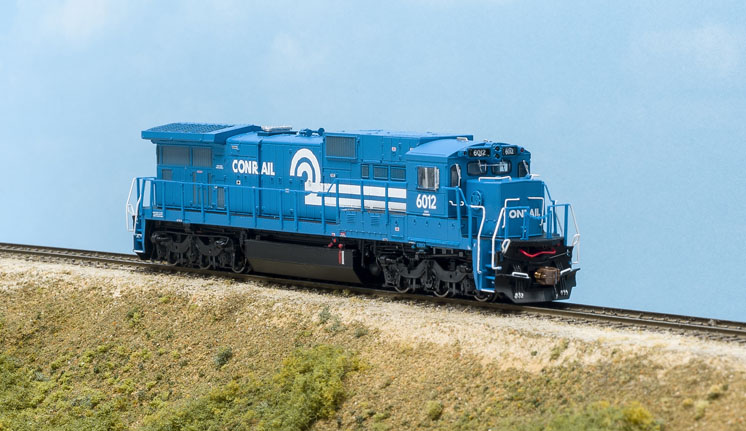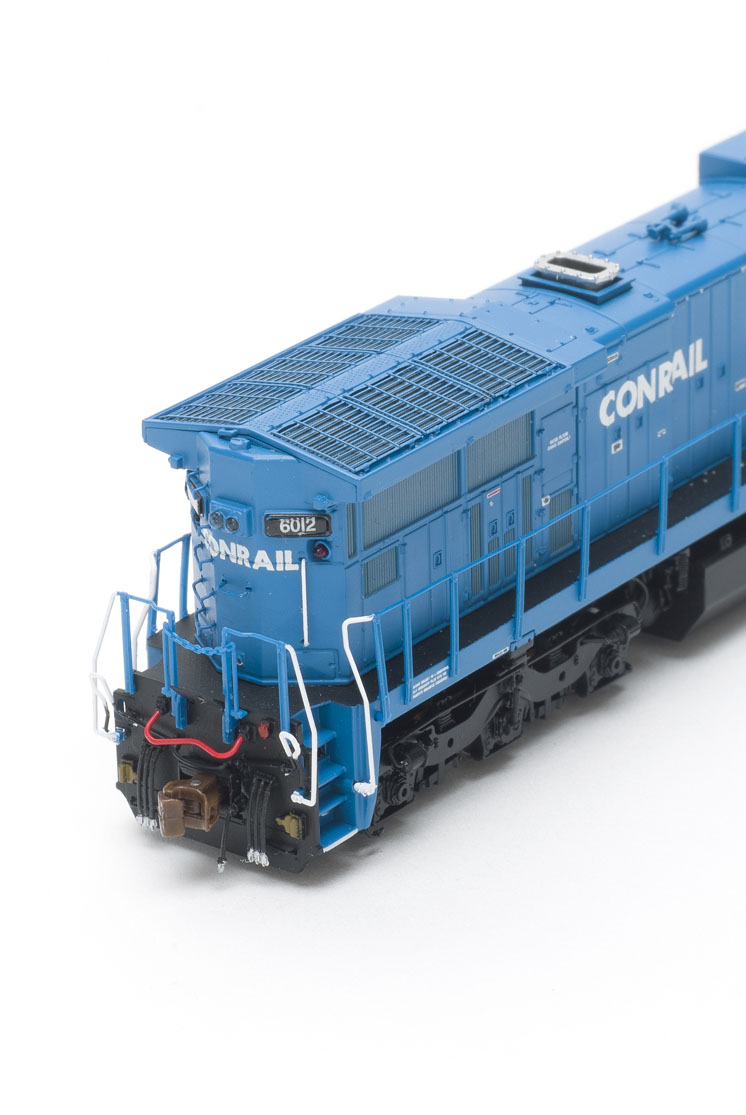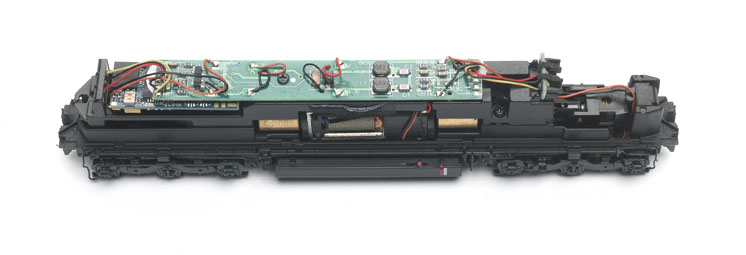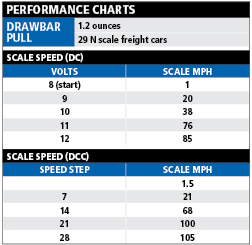For the first time in N scale, a General Electric C39-8 is available as a ready-to-run plastic model. Produced by ScaleTrains.com as part of the firm’s Rivet Counter series, the N scale diesel-electric locomotive features roadname-specific detail. We tested a version that came factory-equipped with an ESU LokSound dual-mode decoder that provides realistic sound and other effects on Digital Command Control (DCC) and direct-current (DC) layouts.
The prototype. General Electric introduced its Dash 8 series of locomotives in the early 1980s. The locomotives featured better microprocessor control and improvements to GE’s FDL line of diesel engines. Among the first Dash 8 locomotives was the six-axle, 3,900 hp C39-8.
Between 1984 and 1987, GE produced 161 C39-8s. Norfolk Southern had the largest fleet with 139 units. The only other original customer was Conrail, which purchased 22 C39-8s. On both roads, the C39-8s hauled all manner of freight along Class 1 main lines throughout the 1980s and 1990s. In 1998, when NS and CSX purchased Conrail, the two roads split up Conrail’s C39-8 fleet. A few of the locomotives were repainted in CSX paint schemes.
By the early 21st century, NS and CSX began retiring the C39-8s. Some found second careers on short lines, including Pennsylvania Northeastern RR and Savage Alberta Ry.
The model. The ScaleTrains.com N scale model matches the major dimensions of a prototype C39-8 given in the Car and Locomotive Cyclopedia of American Practice, Fifth Edition (Simmons-Boardman, 1984). Placement of grab irons, grills, and other details also match prototype photos.
Our review sample models Conrail no. 6012. Like the other Conrail units delivered in 1986, this prototype represents what railfans refer to as a phase III C39-8. The model’s plastic body shell is accurately detailed for its phase III prototype, with a six-panel radiator grill and a separately applied brake wheel. (ScaleTrains.com also makes the carbody in other phases as appropriate for each prototype modeled.)
The ScaleTrains.com model depicts no. 6012 as it appeared in the early to mid-1990s. Era-specific retrofitted details include inverted “L” grab irons on the front of the short hood and a long vertical grab iron on the right rear end of the long hood. As per the CR prototype, there are front and rear red marker lights. However, they are non-operating. Correct for its era, the model doesn’t have ditch lights. These weren’t added to the prototype until 1997.
Other separately applied detail parts include m.u. hoses, windshield wipers, and the correct Leslie RSL-3R air horn mounted on the long hood. Grab irons are made of wire, and handrails and stanchions are flexible engineering plastic. The cab features seats and interior detailing.
The plastic General Steel Castings truck sideframes are especially well done, with separate brake cylinders, piping, and sand lines. The right front truck also has separate handbrake chain detail.
The model is accurately decorated for its 1990s-era Conrail prototype, with clearly printed and properly placed lettering, logos, and stencils. Grab irons, end hand rails, lower step edges, and uncoupling lever ends are all correctly painted white.
The mechanism. After removing both coupler boxes, I could easily lift off the plastic body shell. The dual-flywheel- equipped can motor is mounted in the center of the die-cast metal frame, with more weight attached above it. Driveshafts connect the motor to the truck-mounted gearboxes.
The main printed-circuit (PC) board is atop the mechanism. The ESU LokSound Select Micro decoder is plugged into a Next18 socket under the rear of the PC board. Our sound-equipped sample also includes a well-enclosed sugar cube-style speaker. All lighting is provided by surface-mounted light-emitting diodes (LEDs).
Performance. As shown in the charts at right, the model accelerated smoothly in both DC and DCC speed tests. In DCC tests, the model’s top speed was quite a bit higher than the 70 to 80 mph of the prototype, but this can easily be adjusted with configuration variables (CVs). During force meter testing, the model produced a drawbar pull equivalent to 29 N scale freight cars.
I confirmed that the model will handle 9¾” radius curves, but it looked better rounding the 13″ curves on our Canadian Canyons layout. The C39-8 also had enough pulling power to haul 20 N scale 50-foot freight cars up the 1.9 percent grade of the layout’s helix. The all-wheel electrical pickup ensured reliable operation through turnouts.
Sound. When I set the C39-8 on our DCC-equipped test track and pressed function 8, I heard the 7FDL16 diesel engine start up. Other user-triggered sound effects include the bell, a realistic dynamic brake sequence, coupler crash, and sanding valves. The playable horn effect sounds the Leslie air horn. There are also 15 other prototype horns to choose from by programming CV48.
All functions are also remappable to any available function key. I was easily able to switch the headlights from directional to manual control, which I find more realistic.
The ESU LokSound Select decoder includes the Full Throttle diesel sound and effects package. I especially enjoyed pressing F9, Drive/Hold. This function keeps the locomotive speed steady while the throttle knob is used to manually notch the engine rpm. There’s also a button-controlled independent brake.
All aspects of the decoder can be adjusted using CVs. I programmed the locomotive address to the locomotive number on the cab. Although the model features some built-in starting and stopping momentum, I added a little more. I also thought the default sound volume was a little low, so I turned it up to full.
The decoder supports CVs 19, 21, and 22, so it was easy to set up an advance consist with another DCC-equipped N scale diesel.
A complete programming guide is available for free on the ESU website at www.esu.eu/en/. A LokProgrammer computer interface makes programming LokSound decoders a simpler task. Although this device is sold separately, the LokProgrammer software is available as a free download and can be used without the interface. The software provides CV values that can be entered manually into a DCC system.
On our DC test track, the sound is limited to the engine rpm, which rev up or down according to the locomotive speed. The directional headlights also function in DC.
Exceptional sound and detailing make the N scale C39-8 from ScaleTrains.com an exceptional model of a freight-hauling workhorse of the 1980s and ’90s.
$169.99 (DC no sound)
Manufacturer
ScaleTrains.com Inc.
7598 Highway 411
Benton, TN 37307
www.scaletrains.com
Era: 1986 to early 2000s (early to mid-1990s as detailed for Conrail no. 6012)
Road names (multiple numbers): Conrail, Norfolk Southern, and Pennsylvania Northeastern RR
Features
• All-wheel drive and electrical pickup
• Blackened metal wheels, in gauge
• Body-mounted plastic semi-scale type E knuckle couplers at correct height
• Cab interior
• ESU LokSound Next18 Select Micro dual-mode decoder (DCC version)
• Five-pole, skew-wound motor with dual brass flywheels
• Light-emitting diode headlights and number boxes
• Minimum radius: 93⁄4″, 11″ or greater recommended
• Next 18 DCC socket (DC version)
• Operates on codes 55 and 80 rail
• Weight: 3.7 ounces

















